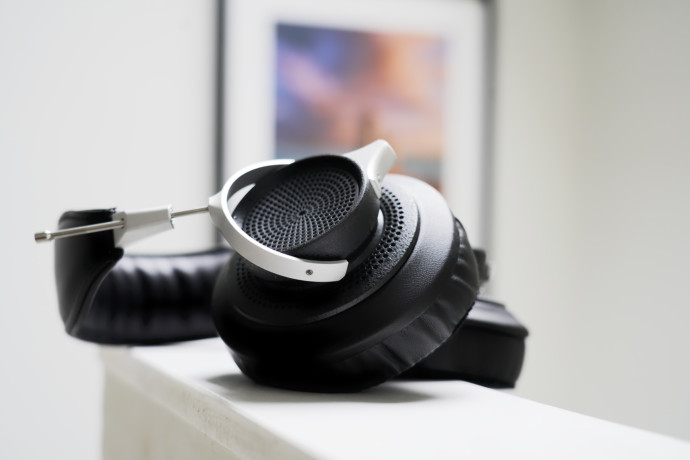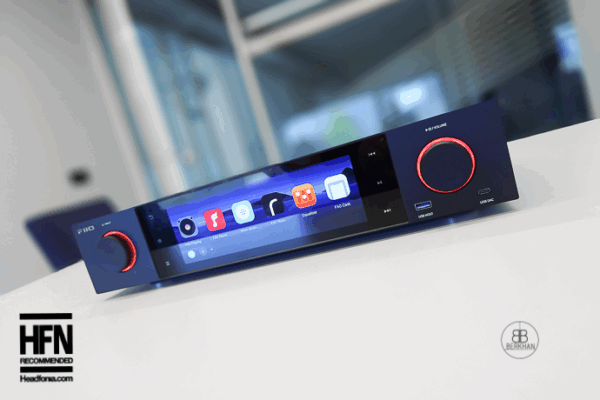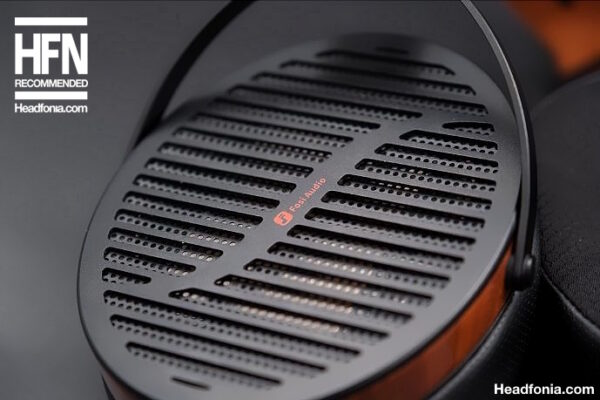If Google is showing you this page directly, click here to go to the start of the article.
Specifications
For the nitpickers and nerdy ones here, I’m giving the specs and technical sheets. For all the others, you can just go to the next page to see how the Mirph-1 performs.
50mm dynamic driver + Open-back design
For their first creation, Mirph played it safe and chose a dynamic driver, fitted into an open-back basket.
A clean design, with classic specs: 32 ohms impedance and a 100dB/mW sensitivity that should require more power than your usual desktop, but not as much as a planar headphone for comparison. Frequency response is surprisingly flat, deviating from the Harman Target – which is a good thing in my opinion – and we should see some nice results in the mid-range area.
To ensure the best possible performance with this transducer, Mirph designed an acoustic chamber, specifically developed for this model, 3D printed to ensure an effective vibration area without the usual backslash inherent to that kind of setup.
A classic design, but let’s see how potent it is.

Bundle
Inside the box
The Mirph-1 comes with a really sparse bundle but, for once, I won’t complain: you can feel that the team decided to lower their carbon footprint, following the modular concept behind the headphone.
In the box, you get:
- the Mirph-1
- an octo-core single crystal copper wire cable with a straight 3.5mm termination (very good one)
- pleather and velour perforated earpads
- a nice leaflet about the brand philosophy
- and… that’s it!
A scarce bundle compared to other headphone models, but again, for a new/small team that’s more than enough, and that default bundle should suit most users.

Additional accessories
What should you add to your Mirph-1? Only two things actually:
First, you could add a good DAC, DAP, or any quality source to enjoy what this headphone has to offer. Personally, I chose the FiiO M17 as my main source when I wanted to go hard on the go, but smaller audiophile sources like the JM21 or even the new Shanling M1 Plus should work.
The second addition would be a balanced cable, the Mirph-1 enjoying classic 3.5mm plugs left and right, making cable swap pretty easy. I chose the ddHiFi BC150B for this one, but any quality balanced cable should work!
Sensitivity / Hiss
With low impedance and moderate sensitivity, the Mirph-1 benefits from a properly amped source to truly shine. While it remains listenable with smaller devices, you’ll want a good DAC/Amp to unlock its full potential.
Paired with the FiiO M17, I found myself sticking to high gain mode to get that extra low-end kick below 100Hz. That said, even with more compact solutions like the FiiO KA11, the Mirph-1 still performed admirably—as long as I stayed in high gain.
My top pick? If money is no object, the Astell&Kern SP3000T would be the ultimate pairing, but in a more reasonable budget, the Activo P1 and FiiO K15 stood out as perfect matches for the Mirph’s sonic signature.

Full specs
- Model: Mirph-1
- Type: open-back headphone
- Style: dynamic driver
- Drivers: 50mm dynamic driver
- Socket: dual stereo-jack
- Cable: custom handmade braided cable with 8 silver-plated copper strands
- Cable plug: 3.5mm
- Material: leather (headband), pleather and velour (earpads), aluminum and stainless steel (moving parts), industrial-grade tough resin (acoustical parts)
- Frequency Response: 20Hz – 20kHz
- Impedance: 32 ohms
- Sensitivity: 100 dB
- Sound Isolation (up to): 0 dB
- Cable length: 200cm
- Weight: 400g excluding cable, 440g including cable
- Price: €695 EUR
The article continues on Page three, after the click here
Page 1: About the brand, design, comfort
Page 2: Specifications, bundle
Page 3: Sound performances









